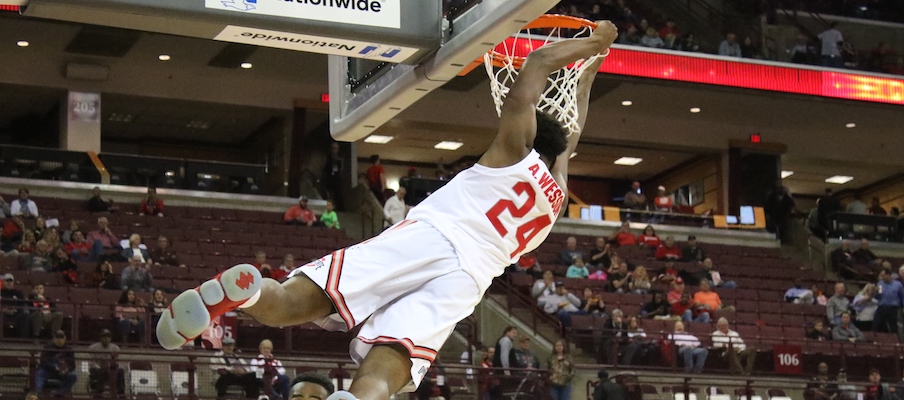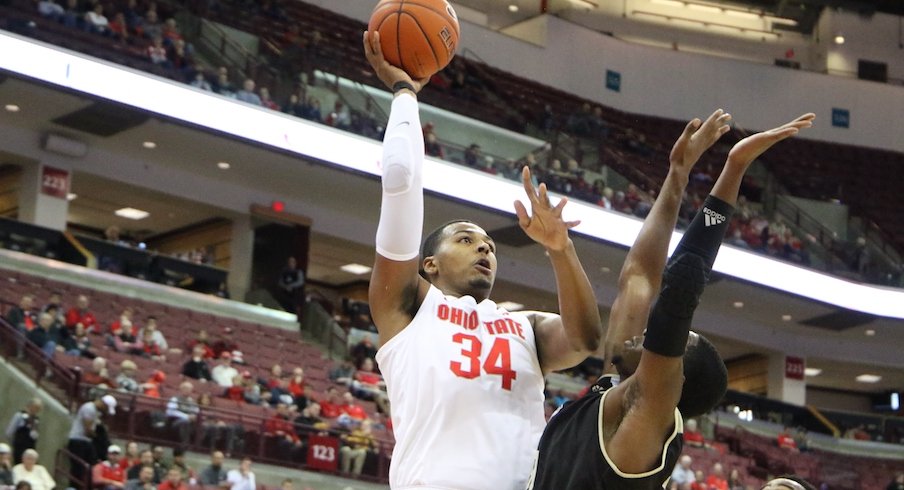Three-star in-state linebacker CJ Sanna commits to Ohio State.
Ohio State never trailed UNC Pembroke.
Kaleb Wesson scored the first points of the game on a second-chance layup, and just over five minutes into the game, the Buckeyes took a double-digit lead. They beat UNC Pembroke 81-63 in Thursday night's exhibition, and at no point did the Braves truly threaten a comeback.
The game left UNC Pembroke coach Ben Miller impressed by the Buckeyes.
"They're picked seventh or eighth in the Big Ten? That's nuts," Miller said. "If that's the eighth-best team in the Big Ten, they're going to shock a lot of people. I was really impressed with their team. They're going to win a lot of games this year."
A visibly agitated Chris Holtmann wasn't nearly as awed with Ohio State. In fact, he came away from the game with more than a few concerns about his group less than a week from the season opener on Wednesday against the Cincinnati Bearcats.
"Lot to take from this game for us, good and bad," Holtmann said. "A lot to take from it. I was glad we got to play a lot of different guys.
"Lot to improve on. We have some significant, significant areas that need improvement. Significant areas."
Here are seven things we learned from Thursday's scrimmage.
Turnovers could be a nagging issue
As the game progressed, Ohio State's turnovers began piling up. Andre Wesson committed their first turnover a little over three minutes into the game. For the remainder of the first half, Ohio State had just one stretch of more than three minutes without committing a turnover.
The Buckeyes ended the half with nine turnovers, then committed 12 more in the second half to finish with 21 turnovers. Holtmann said the team was "way too careless" with the ball, but it wasn't particularly surprising. The coaching staff had seen that issue crop up in practices.
"We've seen guys, certain guys struggle with it, honestly," Holtmann said. "I don't want to call those guys out. We struggle with it collectively, but we've seen some guys struggle with it. As coaches, we've just got to help them make better decisions."
Nine different players committed turnovers. Musa Jallow had a team-high five turnovers, and Andre Wesson coughed the ball up four times. Duane Washington Jr. had three turnovers. C.J. Jackson and Micah Potter each turned the ball over twice.
"We had primary ball-handlers today that have handled the ball for us before and just didn't make great decisions," Holtmann said. "We'll get better in those areas. We will get better in those areas."
Andre Wesson had three assists and zero turnovers in Saturday's secret scrimmage against Xavier, Holtmann said, and Jackson handled the ball well after struggling with turnovers early in the season last year. So he thinks the team will improve in that area.
It's a category that he emphasizes heavily, especially with guards and younger players. Coaches tally up turnovers in practice. Then after practice is completed, the players run "22's" for each turnover committed. A "22" is a sprint down the court and back, then back down the court and back in fewer than 22 seconds.
"(Holtmann) definitely drills into our head that we've got to take care of the ball," Washington said. "Me and Luther have both gotten better. All the guards, everybody on the team has gotten better since we started practicing seriously. It's just a process."
That comment led to this exchange between fellow freshmen Luther Muhammad and Justin Ahrens:
Muhammad: "He hit it on the spot. No one likes running 22's at the end of practice."
Ahrens: "I'm not even a point guard and I know that. Everybody's got to run. We're all known for handling the ball, you know. It's a group effort."
Muhammad: "Be very careful with the ball or you've got 22s."
Ahrens: "Or you're getting taken out."
Muhammad: "That too."
Just a few minutes after Ohio State's four freshmen walked off the podium, Holtmann took the microphone and confirmed that could happen to those who continue to turn the ball over.
"I'm not playing guys extended minutes that can't take care of the ball," Holtmann said. "Not doing it."
Some of the turnover issues could subside given less backups playing during the regular season. But with a few players controlling the ball significantly more than they did last year, it could morph into a serious problem.
Energy and desire won't be problems
Though it was just an exhibition, Jackson kept diving for balls. He slid into the front row trying to snag loose balls a couple times and, at one point, ended up propped up with his feet on a chair and his hands holding his body off the ground after he dove over the front-row seats for a ball that he ultimately couldn't snag.
"C.J. Jackson plays really hard," Holtmann said. "I mean, C.J. Jackson plays really hard."
He wasn't alone in making effort plays.
Kyle Young went tumbling a couple times and completed an and-one dunk without touching the rim due to being pushed back due to a foul. He and Jallow sometimes play with reckless abandon. Andre Wesson enjoys making effort plays and tries hard on defense. Muhammad moves fast and utilizes his athleticism.

"The thing with this group is these guys want to do the right thing," Holtmann said. "They really do want to do the right thing."
The team played hard for the entire game, played defense with a dogged effort and fought for loose balls. Effort didn't seem to be any sort of an issue.
Inexperience could hurt
Many people correctly fretted after Ohio State lost Keita Bates-Diop, Jae'Sean Tate, Kam Williams and Andrew Dakich. Underclassmen, including newcomers, mostly play their former positions, which could lead to some unavoidable issues.
Muhammad and Washington will likely play heavy minutes, but both made mistakes expected of young guards who like the ball in their hands. It'll be a work in progress. Young played just 8.6 minutes per game last year. Andre Wesson came off the bench and played inconsistent minutes. Jallow's playing time caved at the end of the season.
It'll also be the first time for Jackson and Kaleb Wesson to take primary scoring roles on offense. They were secondary scorers last season.
Kaleb Wesson will be a force
Last season, Kaleb Wesson averaged 10.2 points and 4.9 rebounds per game. As the focal point of the offense, both numbers will drastically increase.
He played against an overmatched UNC Pembroke frontcourt on Thursday, so his success in the game should be kept in perspective. But the noticeably slimmed-down Wesson looked impressive in his 16 minutes on the court. He scored 12 points, making 4-of-5 shots, and grabbed 10 rebounds. He went 4-for-4 from the free-throw line.
Wesson missed his only 3-point attempt, but expect him to put up two or three triples per game. Last week, assistant coach Ryan Pedon said he has "earned" the opportunity to shoot more 3-pointers. He has the ability to play both inside and out, and he makes heady passes.
Ohio State will lean heavily on Wesson to continue to provide points this season. On Thursday, he showed he's ready to become the primary scorer that the Buckeyes need him to be.
Potter, who had a team-high 13 points, including four and-one opportunities, also showed his potential as Wesson's backup. He averaged 4.1 points per game last season, but showed the potential to have a larger role in the offense. He played alongside Wesson for a couple minutes, but Holtmann said that won't be a regular frontcourt duo.
Questionable from 3-point range
The Buckeyes hit just 5-of-25 3-point attempts on Thursday. In the weeks leading up to the season beginning, Holtmann and his assistants said Ohio State will likely shoot more 3-pointers despite the loss of Bates-Diop and Williams. They attempted 25 triples on Thursday, but didn't hit nearly enough to make the shooting worth it.

The poor shooting from range didn't worry Holtmann nearly as much as the turnover issues, though.
"I'm not as worried about our shooting because I think some of that is just you're getting the feel and jitters and they had some changing defenses, which obviously we're going to see," Holtmann said. "We weren't playing guys extended minutes."
Holtmann might not be worried, but concern is reasonable. Williams hit 44 percent of his threes last year, and Bates-Diop attempted more than five per game. This year's team might not have a sharpshooter like Williams or a high-volume 3-point shooter like Bates-Diop.
Lot of rebounders
Ohio State beat the Braves by 18 points (81-63), but grabbed 21 more rebounds than them (56-35). Six different players – Kaleb Wesson, Andre Wesson, Jackson, Potter, Jallow and Jaedon LeDee – pulled down at least five rebounds.
"It was a great experience for our guys to be guarded like that and have to try to block out those monsters inside," Miller said.
Twenty-one of the rebounds came on the offensive side of the ball, which led to 21 second-chance points. On nights like Thursday when shots from deep aren't falling, it'll be important for Ohio State's success on the boards to continue. Kaleb Wesson and Potter are solid rebounders inside, and Jallow, Young and Andre Wesson are good rebounders from wing positions.
Holtmann goes with Muhammad and Young in starting lineup
Holtmann emphasized the starting lineup will be "fluid" this season, but it would be fairly surprising if he went with any group of five players in the regular-season opener other than the five he put on the court to begin Thursday's game.
Returning starters Kaleb Wesson and Jackson were joined by Andre Wesson, Muhammad and Young in the starting lineup on Thursday. Andre Wesson was expected to start, but the other two spots weren't necessarily settled.
Holtmann opted to go with those five for two reasons: he believes it's his best defensive group, and he likes having graduate transfer Keyshawn Woods come off the bench with a young guard.
"Woods could really start," Holtmann said. "He's going to play starter minutes. He could definitely be in that starting role. It's just I like him coming off with another inexperienced guard."


